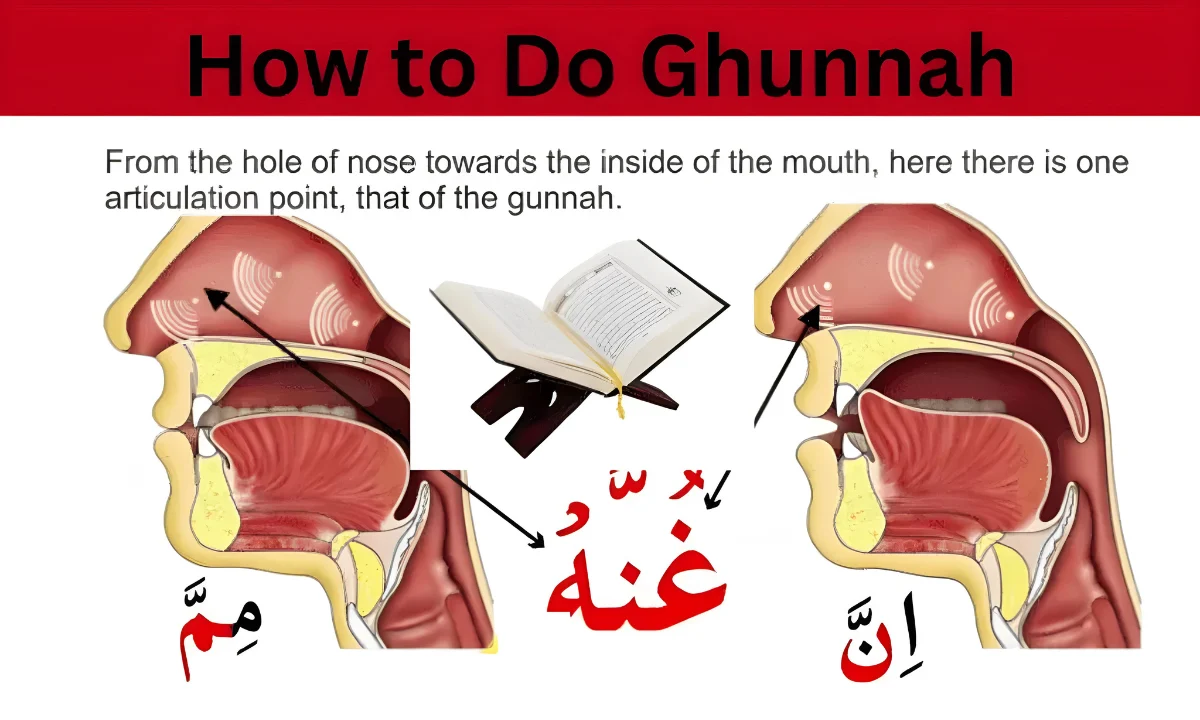
Ghunnah is a significant concept in Arabic phonetics and Quranic recitation. It refers to the nasalization or humming sound when pronouncing specific Arabic letters.
“This sound is created by closing the back of the tongue against the soft palate, allowing air to flow through the nasal passage while speaking.”
What is Ghunnah?
Nasal Sound is a significant aspect of Tajweed, the set of rules for proper Quranic recitation. It refers to the unique nasal sound produced when pronouncing specific Arabic letters under certain conditions.
In simple terms, when you come across the letters “noon” (ن) or “meem” (م) with a sukoon (a diacritic indicating a stop or pause), and they are followed by certain nasal letters, a nasal sound called غُنَّة occurs.
What Does Ghunnah Meaning?
Here’s a simple way to understand it: when you see a “noon” (ن) or “meem” (م) in the Quran with a sukoon (a diacritic indicating a stop or pause), and they are followed by specific letters like “caf,” “noon,” “meem,” “ya,” or “alif,” you make that nasal sound. This unique sound is called غُنَّة.
Doing Nasalization might sound complex, but it’s pretty easy to understand. It’s all about creating a specific sound when you recite certain Arabic letters. Here’s a straightforward and one-of-a-kind way to get it done.

Ghunnah in Tajweed
Tajweed ensures you recite the Quran perfectly, and Nasal Sound is a big part. When you use Ghunnah in Tajweed, you pronounce certain letters correctly. This helps maintain the Quran’s beautiful rhythm and keeps its meaning intact.
So, غُنَّة is the secret ingredient that makes Quranic recitation sound amazing. It’s a must-know for anyone who wants to recite the Quran with precision and excellence.
Types of Ghunnah
Nasal Sound is all about certain special letters in Arabic. There are two main types:
This happens when you have a letter with a little mark called sukoon (ْ), like noon (ن) or meem (م), followed by specific other letters (ق, ن, م, ى, ا). These letters come together to create a unique sound.
Here, you still have noon (ن) or meem (م) with a sukoon, but you pause clearly (waqf) after saying them.

Examples of Ghunnah from the Quran
Here are some examples of Ghunnah in the Quran:
In the verse “يَوْمَ نَدْعُوا۟ كُلَّ أُنَاسٍۢ بِإِمَـٰمِهِمْ” (Surah Al-Isra, 17:71), you can hear Nasal Sound Mutajanisah when pronouncing the word “إِمَـٰمِهِمْ” because the letter meem (م) with a sukoon is followed by the nasal letter ha (هـ).
In verse “ٱنظُرْ إِلَىٰ رَبِّكَ” (Surah Al-Muddaththir, 74:23), you experience غُنَّة Munfasilah in the word “رَبِّكَ” when reciting the letter meem (م) with a sukoon and then pausing before the letter kaaf (ك). This pause adds a rhythm to the Quranic recitation.
The Four Ranks of Ghunnah
The Most Complete Ghunnah (أكمل)
With Shaddah: When “Noon” or “Meem” has a shaddah (a mark indicating emphasis), the Ghunnah is held for two counts. Examples include words like “عمّ” or “إنّها”.
Idgham with Ghunnah: When a “Noon Saakin” (a Noon without a vowel) or Tanween (doubled vowels at the end of words) is followed by the letters و, ن, م, ي, they merge, creating a solid nasal resonance. Find this in verses like “فمن يعمل مثقال ذرة خيرًا يره”.
The Complete Ghunnah (كاملة)
Ikhfaa’ Ash-Shafawi: When a “Meem Saakin” is followed by the letter “Ba” (ب).
The Incomplete Ghunnah (ناقصة)
Izhar Shafawi: A “Meem Saakin” comes before any letter except for “Ba” (ب) or another “Meem” (م).
The Most Incomplete Ghunnah (الأخفى)
Join the Best Online Quran Tajweed Course at Qari.Live and Start your Online Quran Classes from Today.
Frequently Ask Questions (FAQs)
What is Ghunnah in Tajweed?
Ghunnah in Tajweed refers to the nasalization of specific Arabic letters when reciting the Quran.
Can you show me Idghaam with Ghunnah in the Quran?
Idghaam with Ghunnah in the Quran can be seen in verses like “min ghayri ḥiṣāb” (without a count) in Surah Al-Insan (76:17).
Are there examples of Idghaam without Ghunnah in the Quran?
Examples of Idghaam without غُنَّة in the Quran include “fa-raqib” (so ride) in Surah Al-A’raf (7:31).
What are the letters of Ghunnah?
The letters of Ghunnah are م (meem), ن (noon), and ط (ta).
Why is Ghunnah important in Tajweed?
Nasal Sound is important in Tajweed because it affects the pronunciation and proper recitation of Quranic verses.
People Also Ask
Ghunnah sounds like a nasalized humming or vibration when reading the Quran.







